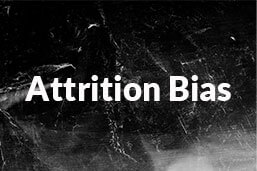
In the realm of research studies, participants occasionally withdraw before a study’s completion. This occurrence, termed as subject mortality or attrition, isn’t just a logistical challenge—it can also introduce a significant research bias. This article delves into the concept of attrition bias, examining its implications and providing guidance on how to address and minimize its influence on research outcomes.
Definition: Attrition Bias
Attrition bias refers to the selective dropout of partakers in research studies. These dropouts may have unique characteristics that are important to the research subject. Therefore, their dropping out may result in a significant difference between the samples at the beginning and end of the study.
Attrition bias
Attrition bias occurs when the participants who leave a study differ in specific ways from those who stay. Therefore, attrition bias is a form of systematic error. Many people assume that attrition bias only occurs when a large number of participants defer from a study. However, the opposite is also true.
In other words, the number of participants who leave does not matter as long as there is a systematic pattern or difference between subjects that stay and leave.
Random attrition
Random attrition is a type of random error where the participants who leave compares to the ones who see the research through to the end. This form of attrition does not have a great impact on the research. However, it can be harmful if the rate of subject mortality is large. In this case, random attrition will reduce your statistical power because you will not have a sufficient sample quantity to make accurate conclusions.
Why attrition bias matters
It is usual for participants to drop out during research. However, the type of attrition that your research experiences is significant. This is because attrition bias or systematic attrition can alter your research findings.
How does attrition bias affect internal and external validity?
One of the most significant impacts of this bias is regarding internal validity.
In research studies, the various rates of subject mortality between the treatment and control group sets can skew results towards one course.
This is because the bias affects the correlation between the different types of variables.
Also, attrition bias can make variables seem related or unrelated when vice versa is true.
In research studies, the various rates of subject mortality between the treatment and control group sets can skew results towards one course.
This is because the bias affects the correlation between the different types of variables.
Also, attrition bias can make variables seem related or unrelated when vice versa is true.
On the other hand, regarding external validity, attrition bias can influence the outcome by skewing your sample and making it significantly different from your original sample. Therefore, this bias causes sample bias, making it difficult for you to generalize your findings to the original sample population.
Ways to prevent attrition
While attrition is a normal occurrence in research, a few measures can help you reduce the rate of participant dropout. The key is to make the study appealing and convenient for the subjects. Below are ways you can do this.
- Offer better compensation for participating in the studies (like cash or gifts)
- Reduce the demands of the studies as much as possible (like the number of follow-ups)
- Make all sessions and follow-ups brief and convenient
- Make time-related demands flexible for participants
- Send routine reminders for follow-ups
- Recruit more subjects than you need, so you have replacements for participants who leave mid-study
- Keep detailed contact data to keep in touch with participants in case they move or are unavailable for one-on-one sessions
How to detect attrition bias
Even with the tips above, you cannot eliminate attrition 100%. Therefore, it would be wise to learn ways to detect attrition bias, so you know how to account for them in your research findings or resolve them. The key is to compare the participants who stay in the study and those who drop out.
You can use baseline data, like demographic variables (age, gender, ethnicity, education, etc.). Furthermore, depending on your study, you can use the variables of interest as the baseline data to compare the participants that leave and stay. Examples of variables of interest you can compare are:
| Age |
| Ethnicity |
| Gender |
| Level of education |
| Socioeconomic status |
| Treatment or control group assignment |
| Level of dependence |
If there is attrition bias, you will note a significant difference between the groups that stay and those that leave. In contrast, if you do not find significant differences, it does not mean that the attribution bias is not present. Instead, your study may have hidden attrition bias.
FAQs
You can reduce attrition bias by compensating participants, minimizing the number of follow-ups or making them flexible and convenient, and sending participants followers
Attrition is when participants in research studies drop out mid-research, causing significant impacts on the outcome. It is a common issue in longitudinal studies.
Another name for attrition is subject mortality. While many people think that subject mortality is when participants die, its true definition is when participants leave a study before it ends.
Attrition bias can distort the findings of your research. For instance, it can result in inaccurate findings due to the differences in the initial and end sample. It also affects internal and external validity in research.
